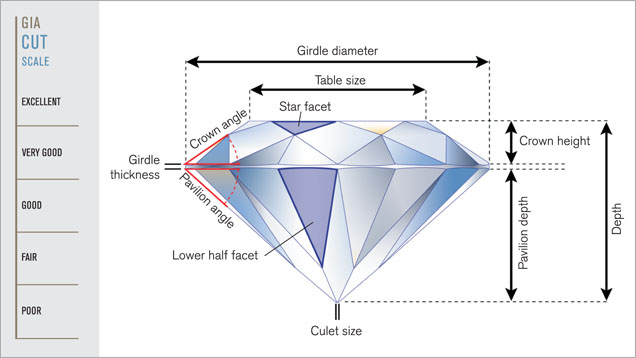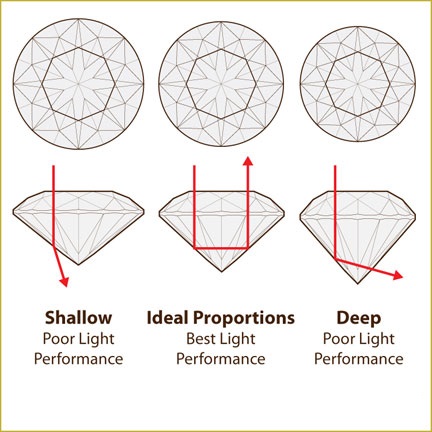This page contains references to diamonds or engagement rings from different companies. Sometimes I do receive a commission when you click on links and buy the products.
The way in which a diamond is cut can have a fundamental effect upon the presentation of the diamond and how it effects light return, giving a diamond that specialized brilliance and fire which is why it is considered the most important aspect of a diamond. It is very possible to have a diamond that has been graded lower in both clarity and color to offer a superior sparkle to one graded higher, simply by the cut. It is important to not confuse cut with the shape of a diamond, jewelers will often use the word cut when referring to shape but care must be taken as they are two very different things. The cut is the aspect that makes the diamond sparkle and which can make a diamond appear ‘more white’ while the shape refers to the outline that the diamond has (heart, cushion, etc.)
To understand how the cut can effect a diamond it is important to have some basic anatomy knowledge to allow a better understanding on what results a gemologist is trying to obtain while cutting and polishing a diamond. The image below shows the anatomy of a diamond.
How is the cut graded?
In an ideal world all diamonds would be cut the same but as it is down to the skill and expertise of the gemologist to do this, there will always be variations in how a diamond is cut and polished. Grades are given during certification of a diamond for the cut, this takes into consideration aspects such as light return, symmetry, girdle outline and brilliance. Diamonds which are cut to ideal or excellent standard will omit a brilliant sparkle and fire, reflecting and refracting light perfectly to obtain a supreme brilliance and fire, bouncing light off the facets equally and to full promote a full effect. The AGS and GIA have their own grading systems for cut, to learn more about Diamond Certification click here. It is to be noted that the GIA can only grade the cut of round brilliant diamonds. The AGS on the other hand have a comprehensive 11 point check list to ensure that their Ideal cut diamonds are without question the best of the best. The 11 different factors are:
Light Performance Factors
- Brightness
- Dispersion (fire)
- Leakage
- Contrast
Proportion Factors
- Girdle Thickness
- Durability
- Weight
- Tilt
- Ratio (spread)
- Culet Size
Finish Factors
- Polish
- Symmetry
This comprehensive factors list ensures that every aspect of the diamonds cut has been considered and as a result can be used for shaped diamonds rather than just round brilliant cut.
How does the cut effect a diamond?
An excellent or ideal cut diamond will sparkle with fire and brilliance even under dull conditions. The principles of how well light returns back to the wearers’ eye is all down to basic physics. If a diamond is cut too shallow or too deep light will leak from the base. As the image below shows, an ideal cut diamond allows light to reflect straight back upwards, giving a true luster and sparkle, making the diamond appear more white and offering exceptional fire, brilliance and sparkle (scintillation).
Fire
An ideal cut diamond will act as a prism, similar to the effects of a rainbow, bending white light to create individual colors of the visible spectrum. These individual colors are referred to as fire.
Brilliance
Brilliance is basically the light return coming from light entering the diamond and returning back. Only a diamond that offers full light return can be classed as being of an ideal or excellent cut.
Scintillation (Sparkle)
Scintillation is the distinctive ‘blinking’ effect that a diamond has when it is moved. As light bounces off the facets and back to the eye a black and white pattern emerges as light enters the diamond, bounces off the facets and returns giving a sparkling effect.
Hearts and Arrows cut
Hearts and Arrows cut diamonds are created using a specialized cut method to create 8 arrows and 8 hearts. This cut and polishing offers an exceptional light return, giving outstanding fire, brilliance and sparkle to create a diamond which is classed as super ideal. Very few diamond companies offer true H&A cut diamonds so if you are thinking about investing in one it is worth going to a reliable and reputable company.
Our full, detailed review on Hearts and Arrows diamonds can be found here.
Fancy cut diamonds
To date, the AGSL is the only gemology laboratory that can grade fancy cut or shaped diamonds. The GIA and other certification boards are only able to grade round brilliant cut diamonds. The methods used for fancy cut diamonds work on similar principles and measurements for optimum light return and as a guideline specific girdle to length ratios were produced for gemologists to follow to create a shaped diamond that can offer the same light return and sparkle as a round brilliant cut diamond would.
Polish
Finally, the way in which a diamond has been polished can have a detrimental or improving factor upon the cut diamond. Polishing each and every angle on the diamond is both time consuming and skilled work. A beautifully polished diamond will emit a much greater luster and sparkle than one that has been poorly polished, even if they have the exact same cut. Equally a poorer cut can be improved slightly with good polishing. Polishing involves making minute scratches upon the surface of the diamond using a specialized tool. During polishing, if these scratches are not smoothed correctly during the final stages light will not return correctly and will be lost within the body of the stone. Again, this goes back to basic physics whereby light can only reflect off a smooth surface.
As with all aspects of the 4 C’s, it is worth investing in a diamond that matches your budget as well as your desires but one thing we do not suggest is compromising on the Cut. A smaller carat diamond can be made to look bigger with an excellent cut, just as one which is has a faint yellow hue can look more white with a good cut. Cut is king.

Richard Jenkins, The Diamond Guru
Get free assistance from the Diamond Guru today. You’ll be glad you did!
- Secure the best quality diamond for your budget.
- Don’t pay over the odds for your diamond ring.
- Have peace of mind that you didn’t get ripped off.
Have a Question? Contact us now…




